Vietnam is an increasingly popular destination for many Malaysian travelers. Whether it’s floating on a boat on Halong Bay, exploring hipster cafes in Ho Chi Minh City, or discovering the history of Hanoi, there’s plenty to do in Vietnam – and plenty of food to eat!
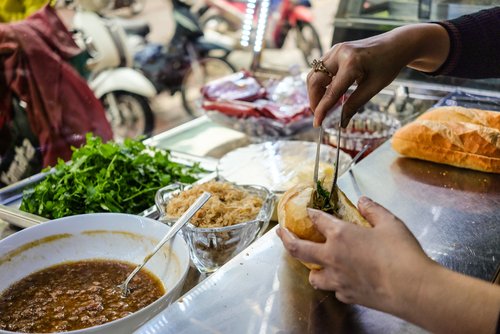
In general, Vietnamese cuisine is full of local agricultural produce like rice, fruits, vegetables and herbs. Its cuisine is often touted as one of the healthiest and most balanced cuisines in the world.
When in Vietnam, look out for certain keywords to find out how a dish is prepared, to help you make better and healthier eating choices:
- Hap (Steamed)
- Nuong (Grilled)
- Rang (Roasted)
- Luoc (Boiled)
- Stir-fried (Xao)
- Fried (Chien)
Here, we take a look at popular Vietnamese meals and dishes that are not just tasty, but healthy and nutritious – so you can eat your way through your travels without the guilt!
1. Pho
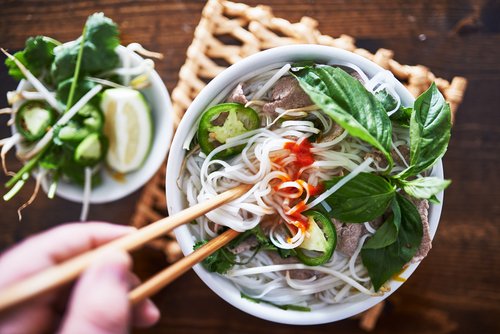
Opt for more vegetables to fill up your bowl and don’t consume all the broth.
There is no escaping Pho when it comes to Vietnamese cuisine. The rice noodle in a meat-based broth dish (usually beef or chicken) is low in calories, usually averaging about 300-450 calories or more per bowl. It can also be low in fat if you choose leaner meats like chicken. However, pho is known to have high amounts of sodium, which can leave you thirsty after your meal. To make this a healthy meal, opt for more vegetables to fill up your bowl and don’t consume all the broth.
2. Banh mi

A relatively balanced meal with carbs, meat and vegetables, the Vietnamese baguette sandwich is a complete meal on its own – minus the fact that white bread does not have the highest nutritional content. Go for unprocessed meats where possible and avoid processed foods like sausages or cheeses. Go easy on the sauce as well, as it may contain high amounts of sugar, salt or fat.
3. Goi cuon
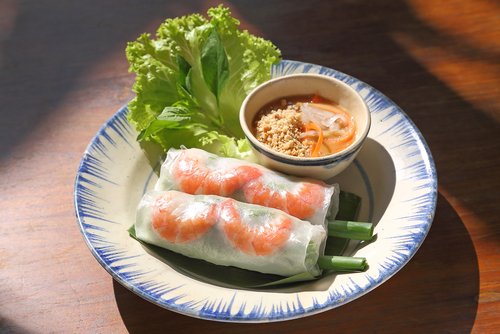
They’re low in fat and oil as they are not deep fried!
Spring or summer rolls are a popular snack in Vietnam. These translucent rice wrappers are filled with fresh vegetables, noodles and herbs (occasionally pork or shrimp too), making them a refreshing yet filling snack. Best of all, they’re low in fat and oil as they are not deep fried!
4. Banh cuon

This savoury rice roll is a traditional dish that’s usually eaten for breakfast. Stuffed with minced meats and mushroom, it is a little similar to the chee cheong fun dish that we find in dim sum shops. What makes Banh Cuon healthy is its cooking method, as it’s steamed over boiling water. Keep this healthy by asking for less fried shallots, which are garnished on top before serving.
5. Goi

Gois, or salads, are just that – healthy and wholesome. Salads in Vietnam rarely come with lettuce but you can be sure it’s full of fresh local produce like green papaya, lotus root, pomelo or even banana flowers! Go for salads with a source of protein like chicken salad (goi ga) which can give you up to 21g of protein per serving on top of the dietary fiber you get from the greens.
6. Bun bo xao
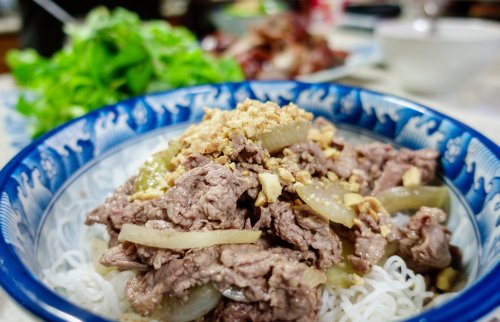
Walking through a typical street of food vendors in Vietnam, one would realize that most of the meals on offer are huge on vegetables – not so much on meat. In fact, in Vietnamese cuisine, meat is rarely the main course but is used more as a condiment or to accompany other ingredients. Even in Bun Bo Xao, the fried beef strips in the warm beef noodle salad are just a topping for the vermicelli and greens.
7. Ca hap
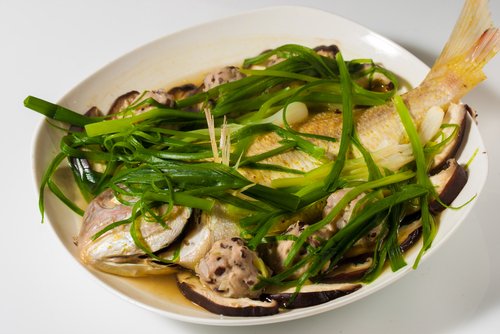
Ordering rice and dishes in a Vietnamese restaurant? Order a serving of steamed fish, also known as CA HAP. Steaming is generally one of the healthiest methods of cooking as it does not use much or any oil at all. A fresh fish coupled with herbs like lemongrass, ginger and garlic as key ingredients really brings out the natural flavour of the fish.
8. Hoa qua dam
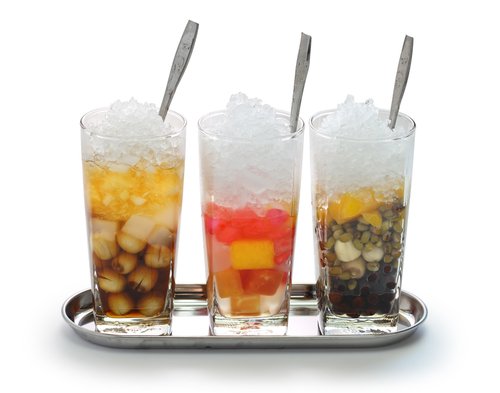
They’re low in fat and oil as they are not deep fried!
Only eat fruits if it’s a banana split? Grab a cup of Hoa Qua Dam, or mixed fruits in a cup. It’s often topped with shaved ice and coconut milk or cream for added textures and flavours. To make this a healthier choice, hold off on the condensed milk.
Most of the time, what makes a dish healthy or less healthy is the method of cooking. For example, vegetables retain much of their nutrients when they’re just lightly cooked, but deep-frying them requires the use of batter, oil and salt – which makes them less healthy.
What makes a dish healthy or less healthy is the method of cooking.
At the end of the day, just remember to balance your guilty pleasures with healthy choices. Happy eating!
References
https://www.verywellfit.com/lower-calorie-healthy-vietnamese-food-3495980
http://www.nola.com/healthy-eating/2017/10/how_to_order_the_healthiest_vi.html
https://alwaysfoodie.com/regional-cuisine-banh-cuon-vietnamese-steam-rice-rolls-healthy.html
https://www.webmd.com/food-recipes/features/discover-vietnamese-cuisine#2
https://www.seriouseats.com/2013/01/vietnamese-dishes-foods-you-should-know-hanoi-saigon-pho-banh...
The above articles are intended for informational purposes only. AIA accepts no responsibility for loss, which may arise from reliance on information contained in the articles.
Related articles

?qlt=85&ts=1695118411437&dpr=off)